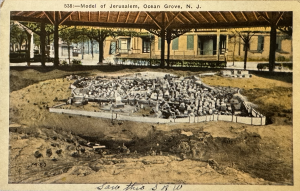 Jericho is probably the best-known archeological site in the Holy Land, with the possible exception of Jerusalem. It has been dug a number of times since the beginning of the 20th century, when the land was still under Ottoman control.
Jericho is probably the best-known archeological site in the Holy Land, with the possible exception of Jerusalem. It has been dug a number of times since the beginning of the 20th century, when the land was still under Ottoman control.
The first excavators were German. This isn’t surprising, since the Ottoman Empire was allied with Germany during World War I. Prior to that, Kaiser Wilhelm II had been busy trying to increase German influence in the Middle East and had even visited Jerusalem during one of his trips before that war.
However, the British have been the major excavators of Jericho. Their first effort at that famous tell was in the 1930s, during the period of the Mandate. The man in charge was John Garstang, who had also excavated the site of Hazor (which I have written about in a previous column). Garstang’s excavation caused a small sensation when he claimed to have found evidence of the Israelite destruction of Jericho caused by Joshua.
But it would be Kathleen Kenyon whose name would be inextricably linked with the excavations of Jericho. Kenyon made Jericho a household name in Canada when she chose A. Douglas Tushingham as her co-director. Tushingham was chief archeologist of Toronto’s Royal Ontario Museum. As a result, newspapers across the country had a field day with the excavations, and the Canadian public became aware of this important archeological site.
Kenyon began her excavations at Jericho in 1952, and she dug there until 1958. Her excavations turned up some fascinating details that would rewrite the history of that famous site and call into question some cherished beliefs. Kenyon was the first to practise the new methodology of excavating that she had learned while working with the legendary British archeologist Mortimer Wheeler. It now bears both their names and is known as the Wheeler-Kenyon method. Basically it involves meticulous excavation, careful recording, and using the stratigraphy at the side of a trench to match up finds with specific soil levels. Ultimately, the idea is to recreate an entire tell from the final published report of the archeologist.
Using this new technique, Kenyon came up with some amazing discoveries. She turned up evidence that Jericho was one of the earliest settlements ever unearthed, dating to the dawn of the Agricultural Revolution, which saw the start of the domestication of both plants and animals. This cultural breakthrough dates back some 10,000 years and was a major milestone in human existence, paving the way for the rise of cities and civilization some 5,000 years later. Coincidentally, this is exactly the same amount of time separating us in the present from the dawn of civilization some 5,000 years ago.
But the most controversial evidence Kenyon turned up dealt with the dating of Joshua’s conquest of Jericho. In fact, there was no evidence of it. Using her meticulous methodology, Kenyon found that at the time of Joshua’s supposed conquest, Jericho lay in ruins, probably having been destroyed by the Egyptians a few hundred years earlier when they were adding Canaan to their empire during the New Kingdom around 1550 to 1100 BCE.
Kenyon’s discoveries have been the source of a great deal of controversy ever since. Some have speculated that the level of Joshua’s conquest may have eroded in the intervening time, but nobody has convincingly refuted her findings.
The excavations of Jericho are a prime example of the danger in using archeology to try to prove the historicity of the Bible. Although the Bible does mention verifiable historical events, it’s not a history book in the modern sense. It’s a chronicle of Israel’s faith, and faith by its very definition defies proof.






